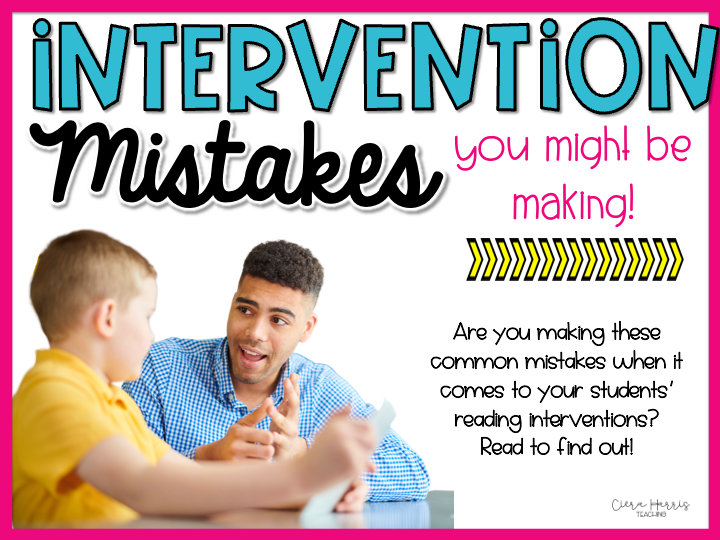Embarking on the journey of implementing reading intervention in elementary education is akin to setting sail on uncharted waters. The goal is crystal clear: to enhance literacy skills and instill a love for reading. However, the seas are not always calm, and there are common mistakes that even the most well-intentioned teachers can make. In this comprehensive exploration, we’ll delve into three critical pitfalls, providing insights into why they happen, the consequences from both teacher and student perspectives, and actionable tips to navigate these challenges. So, let’s hoist the sails and set forth on the quest for literacy success!

Reading Intervention Mistake #1 – Overlooking Individualized Assessment:
Why It Happens:
The oversight of individualized assessments often stems from a myriad of challenges. Time constraints, large class sizes, or the allure of a one-size-fits-all approach can contribute to this error. It’s easy to fall into the trap of assuming that a broad approach will suffice, overlooking the fact that each student’s reading journey is as unique as their fingerprints.
Consequences:
When assessments lack individualization, interventions become a shot in the dark. Students may not receive the targeted support they desperately need, leading to frustration, disengagement, and ultimately, limited progress. From the teacher’s perspective, the lack of accurate assessment hampers their ability to tailor interventions effectively, potentially undermining the overall success of the program.
Prevention Tips:
1. Invest Time in Assessment: Dedicate ample time to comprehensive assessments. Understand each student’s strengths and weaknesses in phonemic awareness, phonics, fluency, vocabulary, and comprehension.
2. Regular Check-ins: Implement a system for ongoing assessment, ensuring interventions remain aligned with students’ evolving needs.
Inconsistent Intervention Implementation:
Why It Happens:
In the whirlwind of a teacher’s responsibilities, consistency often takes a back seat. Time constraints, competing priorities, and unforeseen challenges can disrupt the flow of interventions, leaving students adrift.
Consequences:
Inconsistency breeds uncertainty. Students may experience a start-stop approach to interventions, hindering their ability to establish a routine and hampering the effectiveness of the program. From the teacher’s perspective, inconsistent implementation can result in a lack of trust from students and colleagues, potentially undermining the credibility of the intervention efforts.
Prevention Tips:
1. Create a Schedule: Develop a realistic intervention schedule that aligns with the overall curriculum. Consistency breeds success, and a well-structured plan helps maintain that consistency.
2. Prioritize Flexibility: Anticipate interruptions and plan for flexibility. Having a backup plan for missed sessions or unforeseen events ensures that interventions remain on track.
Quick Fix: Have ready to go, rigorous and meaningful interventions at your fingertips so you have them when you need them! Check out my print & go reading comprehension interventions now inside my store! Click the button below to head over! ⬇️
Print & Go Reading Interventions!

Reading Intervention Mistake #3: Overemphasizing Phonics at the Expense of Comprehension:
Why It Happens:
Phonics instruction is undoubtedly crucial in early literacy, but sometimes, teachers get caught up in the mechanics and forget the ultimate goal – comprehension. The pressure to build strong foundational skills can inadvertently sideline the development of higher-order thinking.
Consequences:
While students may decode like champions, their comprehension skills suffer. They may read fluently yet struggle to extract meaning from the text, leading to a superficial understanding that hampers critical thinking. From the teacher’s perspective, an overemphasis on phonics may yield proficient decoders but falls short of producing well-rounded readers.
Prevention Tips:
1. Balance is Key: Integrate phonics and comprehension activities harmoniously. Allocate time for both, ensuring a holistic approach to reading.
2. Explicitly Teach Strategies: Equip students with comprehension strategies like visualization, questioning, and summarization. These tools empower them to navigate the intricacies of understanding written material.
Navigating the challenges of reading interventions demands a keen awareness of potential pitfalls. By avoiding the common mistakes of overlooking individualized assessment, overemphasizing phonics, and inconsistent implementation, teachers can chart a course toward literacy success. Every misstep is an opportunity to learn, adapt, and ultimately guide young minds toward a lifelong love of reading. So, let’s keep the sails raised, the compass steady, and continue on the path to cultivating literate, curious minds.
Pin the image below to save for later!






